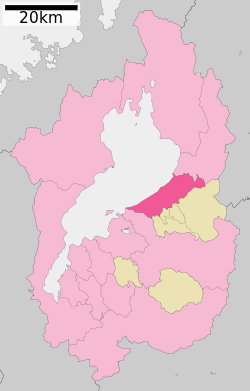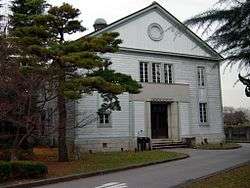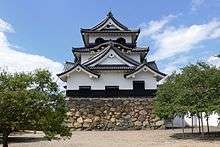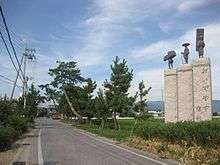Hikone, Shiga
Hikone (彦根市, Hikone-shi) is a city located in Shiga Prefecture, Japan. It is on the eastern shore of the Lake Biwa. The city was incorporated on February 11, 1937.
Hikone 彦根市 | |
|---|---|
City central, Lake Biwa and Hikone castle viewed from Sawayama castle ruin | |
 Flag  Emblem | |
 Location of Hikone in Shiga | |
 Hikone Location in Japan | |
| Coordinates: 35°16′N 136°16′E | |
| Country | Japan |
| Region | Kansai |
| Prefecture | Shiga |
| Government | |
| • Mayor | Takashi Ōkubo (since May 2013) |
| Area | |
| • Total | 196.84 km2 (76.00 sq mi) |
| Population (October 1, 2016) | |
| • Total | 113,349 |
| • Density | 580/km2 (1,500/sq mi) |
| Symbols | |
| • Tree | Tachibana Orange |
| • Flower | Iris |
| Time zone | UTC+9 (JST) |
| City hall address | 4-2 Motomachi, Hikone-shi, Shiga-ken 522-8501 |
| Website | www |
As of October 1, 2016, the city has an estimated population of 113,349 and a population density of 580 persons per km². The total area is 196.84 km².
The key industries of Hikone are the manufacturing of butsudan, textiles, and valves. Bridgestone has a tire manufacturing plant here. Fujitec, Ohmi Railway, and Heiwadō (the largest supermarket chain in Shiga) are headquartered in Hikone.
In 2003, meetings were held to discuss the merger of Hikone with the towns of Toyosato, Kōra, and Taga (all from Inukami District). However, a survey conducted by the city in February 2004, revealed that most of the citizens opposed the merger, leading the city government to shelve the proposal for the time being.
Unlike in most parts of Japan, carrom is still popular here ever since it was introduced in the early 20th century.
History
Hikone was originally a market town that developed around a Buddhist temple. The temple was called Hogon-ji and was said to have been founded in 1080.[1]
Hikone's most famous historical site is Hikone Castle. Its construction was begun in 1603 by Ii Naokatsu, son of the former lord, Ii Naomasa, but was not completed until 1622. Naokatsu's lands had been taken from him in the interval by the Tokugawa shogunate, and when his brother Naotake assumed control of Ōmi Province, he was able to complete the castle by collecting stones from the former Sawayama Castle.
When the Meiji period began in 1868, many castles were scheduled to be dismantled and only a request from the Emperor Meiji himself, touring the area, kept Hikone Castle intact. Today it remains one of the oldest original-construction castles in Japan. In 1937, Hikone became a charter city and developed into a small center of light commerce and industry.[1] In 1999, a small area south of the castle, called the Yume Kyōbashi Castle Road, was built in the old style and attracts visitors keen to see modern construction fused with traditional looks. Even the Kansai Urban Bank in this district has remodeled itself to fit in with the surrounding structures.
The Chōsenjin Kaidō and the Nakasendō were passed through Hikone. The Nakasendō was one of the most important trading routes during the Edo period, and is home to two former post stations, Toriimoto-juku and Takamiya-juku.
Climate
Hikone has a humid subtropical climate (Köppen climate classification Cfa) with hot, humid summers and cool winters. Precipitation is significant throughout the year, but is somewhat lower in winter.
| Climate data for Hikone Local Meteorological Office. (Shiromachi Hikone, elevation 87 m (285 ft)) | |||||||||||||
|---|---|---|---|---|---|---|---|---|---|---|---|---|---|
| Month | Jan | Feb | Mar | Apr | May | Jun | Jul | Aug | Sep | Oct | Nov | Dec | Year |
| Record high °C (°F) | 17.2 (63.0) |
19.9 (67.8) |
24.5 (76.1) |
28.7 (83.7) |
31.6 (88.9) |
35.2 (95.4) |
37.7 (99.9) |
37.5 (99.5) |
35.7 (96.3) |
32.1 (89.8) |
24.4 (75.9) |
20.7 (69.3) |
37.7 (99.9) |
| Average high °C (°F) | 6.8 (44.2) |
7.3 (45.1) |
11.0 (51.8) |
17.3 (63.1) |
22.1 (71.8) |
25.7 (78.3) |
29.7 (85.5) |
31.6 (88.9) |
27.3 (81.1) |
21.3 (70.3) |
15.3 (59.5) |
9.8 (49.6) |
18.8 (65.8) |
| Daily mean °C (°F) | 3.7 (38.7) |
3.9 (39.0) |
6.9 (44.4) |
12.3 (54.1) |
17.2 (63.0) |
21.4 (70.5) |
25.6 (78.1) |
27.1 (80.8) |
23.2 (73.8) |
17.1 (62.8) |
11.4 (52.5) |
6.3 (43.3) |
14.7 (58.4) |
| Average low °C (°F) | 0.7 (33.3) |
0.8 (33.4) |
3.3 (37.9) |
8.0 (46.4) |
13.1 (55.6) |
18.0 (64.4) |
22.4 (72.3) |
23.6 (74.5) |
19.9 (67.8) |
13.4 (56.1) |
7.6 (45.7) |
2.9 (37.2) |
11.1 (52.0) |
| Record low °C (°F) | −11.3 (11.7) |
−8.9 (16.0) |
−7.9 (17.8) |
−2.1 (28.2) |
0.9 (33.6) |
6.9 (44.4) |
12.8 (55.0) |
14.0 (57.2) |
8.3 (46.9) |
1.5 (34.7) |
−2.4 (27.7) |
−8.7 (16.3) |
−11.3 (11.7) |
| Average precipitation mm (inches) | 106.9 (4.21) |
102.2 (4.02) |
120.1 (4.73) |
114.1 (4.49) |
150.2 (5.91) |
190.5 (7.50) |
217.7 (8.57) |
109.0 (4.29) |
168.8 (6.65) |
115.5 (4.55) |
84.5 (3.33) |
91.1 (3.59) |
1,570.9 (61.85) |
| Average snowfall cm (inches) | 44 (17) |
40 (16) |
6 (2.4) |
— | — | — | — | — | — | — | 0 (0) |
14 (5.5) |
104 (41) |
| Average precipitation days (≥ 1.0 mm) | 14.1 | 12.3 | 12.4 | 10.3 | 10.4 | 11.8 | 12.3 | 7.5 | 10.4 | 8.9 | 8.9 | 12.1 | 131.4 |
| Mean monthly sunshine hours | 98.5 | 110.9 | 153.3 | 182.1 | 191.6 | 153.7 | 167.6 | 209.1 | 156.5 | 163.3 | 130.1 | 109.3 | 1,825.8 |
| Source 1: Japan Meteorological Agency (1981 - 2010)[2] | |||||||||||||
| Source 2: Japan Meteorological Agency[3] | |||||||||||||
Education

There are three universities in Hikone: Seisen University, Shiga University, and The University of Shiga Prefecture (USP).
The Hikone campus of Shiga University (National), the 1st Higher Education Institution in Hikone and also in Shiga Prefecture as a university, has its origin in the establishment of the Hikone Commercial College in 1922.
USP is known for its award-winning Schools of Engineering, Environmental Science, and Human Cultures. Recently, USP has begun its Department of Intercultural Communication where most students can study abroad for up to a year as their graduation requirement.
Hikone is also the home of the Japan Center for Michigan Universities (JCMU), a facility operated jointly by a consortium of the fifteen public universities in the State of Michigan and the government of Shiga Prefecture (in coordination with USP) that offers programs for American university students and scholars for the study of Japanese language and culture, as well as courses in English for the citizens of Shiga Prefecture. The Michigan Center, as it is known, was founded in 1989, under the auspices of the Michigan-Shiga Sister State Agreement, the oldest such relationship between a US state and Japanese prefecture.
Sister cities
Hikone is twinned with the following two cities.[4]


See also
References
- Schellinger, Paul; Salkin, Robert, eds. (1996). International Dictionary of Historic Places, Volume 5: Asia and Oceania. Chicago: Fitzroy Dearborn Publishers. pp. 338, 339. ISBN 1-884964-04-4.
- 彦根 1981-2010年 (in Japanese). Japan Meteorological Agency. Retrieved 29 June 2018.
- 彦根 観測史上1~10位の値 (in Japanese). Japan Meteorological Agency. Retrieved 29 June 2018.
- International relations Archived 2012-12-14 at the Wayback Machine Retrieved 7 November 2012
External links
| Wikimedia Commons has media related to Hikone, Shiga. |
- Hikone City official website (in Japanese, English, and Portuguese)
| Wikivoyage has a travel guide for Hikone. |

